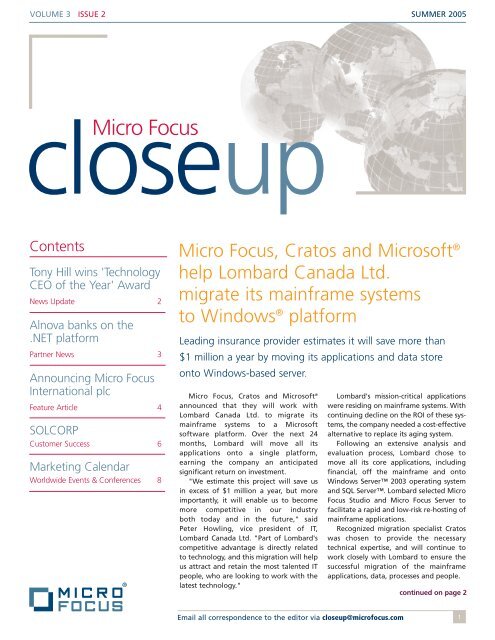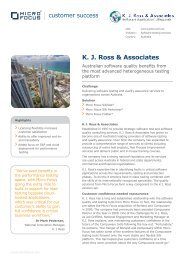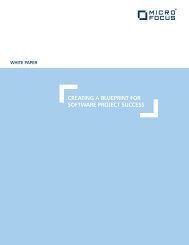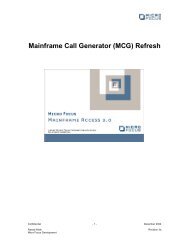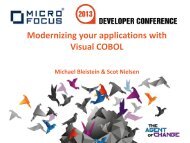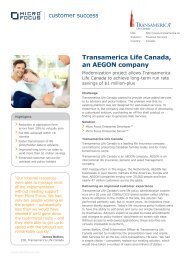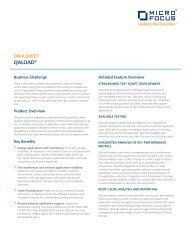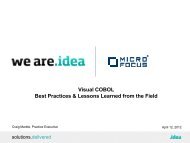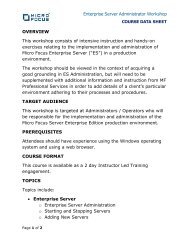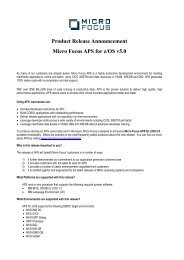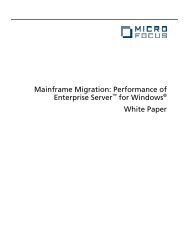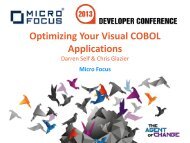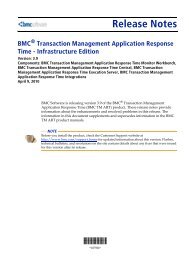Micro Focus
Micro Focus
Micro Focus
Create successful ePaper yourself
Turn your PDF publications into a flip-book with our unique Google optimized e-Paper software.
VOLUME 3 ISSUE 2<br />
closeup<br />
<strong>Micro</strong> <strong>Focus</strong><br />
Contents<br />
Tony Hill wins 'Technology<br />
CEO of the Year' Award<br />
News Update 2<br />
Alnova banks on the<br />
.NET platform<br />
Partner News 3<br />
Announcing <strong>Micro</strong> <strong>Focus</strong><br />
International plc<br />
Feature Article 4<br />
SOLCORP<br />
Customer Success 6<br />
Marketing Calendar<br />
Worldwide Events & Conferences 8<br />
Leading insurance provider estimates it will save more than<br />
$1 million a year by moving its applications and data store<br />
onto Windows-based server.<br />
<strong>Micro</strong> <strong>Focus</strong>, Cratos and <strong>Micro</strong>soft ®<br />
announced that they will work with<br />
Lombard Canada Ltd. to migrate its<br />
mainframe systems to a <strong>Micro</strong>soft<br />
software platform. Over the next 24<br />
months, Lombard will move all its<br />
applications onto a single platform,<br />
earning the company an anticipated<br />
significant return on investment.<br />
"We estimate this project will save us<br />
in excess of $1 million a year, but more<br />
importantly, it will enable us to become<br />
more competitive in our industry<br />
both today and in the future," said<br />
Peter Howling, vice president of IT,<br />
Lombard Canada Ltd. "Part of Lombard's<br />
competitive advantage is directly related<br />
to technology, and this migration will help<br />
us attract and retain the most talented IT<br />
people, who are looking to work with the<br />
latest technology."<br />
SUMMER 2005<br />
<strong>Micro</strong> <strong>Focus</strong>, Cratos and <strong>Micro</strong>soft ®<br />
help Lombard Canada Ltd.<br />
migrate its mainframe systems<br />
to Windows ® platform<br />
Lombard's mission-critical applications<br />
were residing on mainframe systems. With<br />
continuing decline on the ROI of these systems,<br />
the company needed a cost-effective<br />
alternative to replace its aging system.<br />
Following an extensive analysis and<br />
evaluation process, Lombard chose to<br />
move all its core applications, including<br />
financial, off the mainframe and onto<br />
Windows Server 2003 operating system<br />
and SQL Server. Lombard selected <strong>Micro</strong><br />
<strong>Focus</strong> Studio and <strong>Micro</strong> <strong>Focus</strong> Server to<br />
facilitate a rapid and low-risk re-hosting of<br />
mainframe applications.<br />
Recognized migration specialist Cratos<br />
was chosen to provide the necessary<br />
technical expertise, and will continue to<br />
work closely with Lombard to ensure the<br />
successful migration of the mainframe<br />
applications, data, processes and people.<br />
Email all correspondence to the editor via closeup@microfocus.com<br />
continued on page 2<br />
1
News Update<br />
<strong>Micro</strong> <strong>Focus</strong>, Cratos and <strong>Micro</strong>soft...<br />
"Lombard is among a leading group of<br />
companies that want to derive further<br />
value from their COBOL, CICS and JCL<br />
based legacy systems by migrating from<br />
the mainframe to the low cost, high<br />
performance Windows platform," said Ian<br />
Archbell, vice president of product<br />
management, <strong>Micro</strong> <strong>Focus</strong>. "We are<br />
pleased that our collaboration with Cratos<br />
and <strong>Micro</strong>soft will deliver a rapid migration<br />
solution for Lombard, lowering its IT<br />
hardware and software costs, while<br />
increasing its business agility."<br />
"By migrating to the new platform<br />
and running <strong>Micro</strong> <strong>Focus</strong> and<br />
<strong>Micro</strong>soft technology solutions,<br />
Lombard will enjoy the same<br />
end-user functionality with<br />
anticipated reduced development<br />
and deployment costs..."<br />
"We are delighted to be leading the<br />
'Lift and Shift' migration of Lombard's<br />
mainframe systems," said Andrew P. Wickett,<br />
chief executive officer, Cratos Technology<br />
Solutions. "By migrating to the new<br />
platform and running <strong>Micro</strong> <strong>Focus</strong> and<br />
<strong>Micro</strong>soft technology solutions, Lombard<br />
will enjoy the same end-user functionality<br />
with anticipated reduced development<br />
and deployment costs, and achieve an<br />
expected return of investment within less<br />
than 18 months."<br />
"Mainframe customers are facing<br />
several challenges, including a decrease in<br />
available technical skills, shortage of<br />
innovation in the ISV ecosystem, and a<br />
2<br />
"We are working with services<br />
partners like Cratos, and Mainframe<br />
Migration Alliance partners like <strong>Micro</strong><br />
<strong>Focus</strong>, to provide the resources, tools<br />
and education customers need to<br />
achieve a successful migration."<br />
need for increased flexibility. Migrating to<br />
newer technologies delivers the agility<br />
they need to adapt to continuously changing<br />
business requirements at a lower cost,<br />
without sacrificing the scalability, reliability<br />
and security they have come to expect<br />
from the mainframe," said Randy<br />
Lenaghan, director of financial services,<br />
<strong>Micro</strong>soft Canada. "We are working with<br />
services partners like Cratos, and<br />
Mainframe Migration Alliance partners<br />
like <strong>Micro</strong> <strong>Focus</strong>, to provide the resources,<br />
tools and education customers need to<br />
achieve a successful migration."<br />
For more information visit:<br />
www.cratos.ca<br />
Tony Hill wins ‘Technology<br />
CEO of the Year’ Award<br />
<strong>Micro</strong> <strong>Focus</strong> announced that Tony Hill has won the<br />
prestigious 'Technology CEO of the Year' Award at the<br />
UK Technology Innovation & Growth Awards 2005<br />
In just over three years, Tony has taken<br />
<strong>Micro</strong> <strong>Focus</strong> from an 'orphan' division<br />
spun out from Merant, plc (recently<br />
acquired by Serena Software) to a leader<br />
in legacy application development and<br />
deployment on contemporary platforms.<br />
He has also been an industry thought<br />
leader, changing the perception of legacy<br />
IT from that of a liability to an asset.<br />
The judges felt that Tony's visionary<br />
leadership and hands-on approach, combined<br />
with transforming <strong>Micro</strong> <strong>Focus</strong><br />
from a COBOL tools company to a worldclass<br />
leader in legacy modernization, were<br />
decisive factors in the decision to honor<br />
him with the award.<br />
Under Tony's leadership, <strong>Micro</strong> <strong>Focus</strong><br />
has established a strong ecosystem of<br />
partners addressing legacy IT issues, fostering<br />
an environment in which <strong>Micro</strong><br />
<strong>Focus</strong> has developed strong relationships<br />
About CRATOS Technology Solutions Inc.<br />
Cratos, established in 1999, is headquartered<br />
in Oakville, Ontario, a suburb of<br />
Toronto. Cratos is a software solutions<br />
company specializing in international<br />
banking and financial transaction processing.<br />
The majority of Cratos clients consist<br />
of banks and financial institutions who use<br />
the processing software for services such as<br />
Visa ® , MasterCard ® , Eurocard ® , smart cards,<br />
debit cards, other credit cards, store cards,<br />
private label cards and loyalty based<br />
products. Revenues are primarily<br />
generated from large financial institutions<br />
throughout North America, Europe and<br />
Australia. Projects undertaken by Cratos<br />
usually extend from a few months to over<br />
one year in duration.<br />
with industry leaders including CSC, EDS,<br />
HP, <strong>Micro</strong>soft, Oracle and others.<br />
More than 650 guests gathered to<br />
discover the winners of the awards. Now<br />
in their seventh year, the awards are<br />
designed to celebrate the companies and<br />
individuals that have demonstrated the<br />
innovation and entrepreneurial flair that<br />
is vital to the health and growth of the UK<br />
technology industry.<br />
"It is a great honor to receive this<br />
award," said Tony Hill, chief executive<br />
officer, <strong>Micro</strong> <strong>Focus</strong>. "<strong>Micro</strong> <strong>Focus</strong> has<br />
grown beyond all expectations over the<br />
last three years and together with our<br />
partners is helping businesses reduce<br />
costs, increase agility and mitigate risk by<br />
reusing legacy assets. This award reflects<br />
the hard work that the whole company<br />
has contributed over the last three years,<br />
and is a credit to the entire organization."
Partner News<br />
Alnova Financial Solutions<br />
banks on the .NET platform<br />
Alnova Financial Solutions (Alnova) uses Net Express ® to expand<br />
the customer base of its Financial Solutions product suite by<br />
enabling its core retail banking solution to run on the low-cost,<br />
high-performance Windows ® .NET platform, while utilizing<br />
the existing and proven<br />
mainframe-based<br />
assets.<br />
Alnova, one of the solutions in the<br />
Accenture insurance and banking portfolio,<br />
is an end-to-end, modular banking system<br />
designed to provide retail banks with integrated<br />
customer-centric financial services. It<br />
allows financial institutions to solve many<br />
IT issues and to increase service capabilities<br />
and revenues while containing – and often<br />
reducing – costs.<br />
The Project<br />
Accenture observed a growing number<br />
of small to medium-sized banks (those with<br />
up to five million accounts) trying to<br />
compete with larger players while having<br />
to control IT costs and maintain customer<br />
focus. These small to medium-sized banks<br />
needed a flexible and scaleable IT solution,<br />
and Accenture wanted to provide a<br />
product tailored to their needs.<br />
"Only 10 developers had to work on<br />
the project, and some processes<br />
which are normally very time-intensive<br />
and complicated only took a few<br />
seconds..."<br />
Creating a solution from scratch would<br />
have been neither fast nor effective, and<br />
Accenture wanted to leverage its existing<br />
and proven Alnova mainframe-based<br />
system as far as possible. The goal was to<br />
create the Alnova .NET suite of products,<br />
which, in order to comply with maintainability<br />
and cost management requirements,<br />
had to be done by maintaining a<br />
unique business logic source code for any<br />
platform. The bulk of the mainframe system<br />
was written in COBOL, and Accenture<br />
turned to <strong>Micro</strong> <strong>Focus</strong> Net Express to<br />
support the re-use and extension of the<br />
existing Alnova mainframe application to<br />
the <strong>Micro</strong>soft ® .NET Framework.<br />
"We selected <strong>Micro</strong> <strong>Focus</strong> because it was<br />
the most mature compiler we looked at,<br />
with the highest mainframe compatibility<br />
and strong technical support. Our developers<br />
did not have to spend more time – and<br />
money – making changes to our existing<br />
source code,” said Zigor de la Quintana,<br />
alliances manager, Accenture.<br />
Making it work<br />
The existing Alnova mainframe system is<br />
large, consisting of 11 million lines of<br />
COBOL code across 5,500 COBOL programs.<br />
Accenture needed to re-use this business<br />
code while designing and implementing a<br />
contemporary technical architecture.<br />
Performance was also critical, as any<br />
solution for banks with five million or more<br />
accounts must be robust and scalable. The<br />
data access code was preserved to a very<br />
high level because Accenture adopted<br />
<strong>Micro</strong>soft SQLServer using OpenESQL<br />
support with-in Net Express.<br />
"Only 10 developers had to work on the<br />
project, and some processes which are<br />
normally very time-intensive and complicated<br />
only took a few seconds - Net Express<br />
was certainly the most user-friendly and<br />
flexible solution we evaluated," said<br />
Soledad Lahulla, product technical<br />
development director, Accenture.<br />
Accenture selected Net Express because<br />
it was the only solution they evaluated<br />
which included sufficiently strong mainframe<br />
COBOL compatibility. It also allowed<br />
Accenture's programmers to include some<br />
specific features of the Alnova platform<br />
without having to make any changes to the<br />
source code business logic. Only 10 developers<br />
were needed to compile the source<br />
code for the .NET platform.<br />
Using Net Express, Accenture successfully<br />
and rapidly migrated the COBOL core<br />
base of its application to Windows. Following<br />
the initial implementation, Accenture<br />
embarked on a series of large scale benchmarks<br />
to determine and prove the scalability<br />
of the migrated system. Using an 8-way<br />
machine attached by a 24 CPU application<br />
servers farm, Accenture was able to obtain<br />
250 transactions-per-second. This easily<br />
proved the performance and scalability of<br />
the solution, providing more than enough<br />
processing power for the target banks<br />
along with a dramatic reduction in<br />
hardware infrastructure.<br />
Alnova now delivers a large-scale<br />
mainframe COBOL application to a<br />
new and expanded customer base,<br />
with all the advantages associated<br />
with modern, agile business systems<br />
under <strong>Micro</strong>soft Windows...<br />
Winning new customers<br />
As a result of the migration, Accenture<br />
was able to incorporate new features in the<br />
existing system, and to wrap COBOL<br />
business logic using web services technology<br />
to align the solution to a services<br />
oriented architecture (SOA).<br />
Alnova now delivers a large-scale<br />
mainframe COBOL application to a new<br />
and expanded customer base, with all the<br />
advantages associated with modern, agile<br />
business systems under <strong>Micro</strong>soft Windows,<br />
and the Alnova .NET solution has already<br />
won several major customers.<br />
3
Feature Article<br />
Successful IPO in May 2005<br />
Commenting on the results, Tony Hill,<br />
Chief Executive Officer of <strong>Micro</strong> <strong>Focus</strong>, said:<br />
"We are pleased to announce a strong set<br />
of full-year results, building on the<br />
substantial revenue and operating profit<br />
growth the Company has achieved since its<br />
independence in August 2001. We believe<br />
this financial performance is further<br />
endorsement of our technology leadership<br />
and our strong and growing network of<br />
business partners.<br />
As companies around the world seek to<br />
reduce operating cost and become more<br />
agile, so they are increasingly looking to<br />
exploit their investment in legacy IT assets.<br />
By helping our customers manage legacy<br />
more effectively and drive reuse within<br />
contemporary contexts, <strong>Micro</strong> <strong>Focus</strong><br />
unlocks business value. Moreover, our<br />
evolutionary approach comes with much<br />
less risk than alternative strategies based<br />
on wholesale system replacement.<br />
Our business model is continuing to<br />
prove its value. In recent months we have<br />
achieved greater penetration of our target<br />
markets and, following the IPO and the<br />
repayment of debt, we are financially well<br />
positioned to maintain profitable growth<br />
and generate cash. The Company<br />
continues to make good progress and is<br />
well positioned for continued growth in<br />
the year ahead."<br />
4<br />
Announcing:<br />
<strong>Micro</strong> <strong>Focus</strong> International plc<br />
On May 17, 2005 <strong>Micro</strong> <strong>Focus</strong> International plc ("<strong>Micro</strong> <strong>Focus</strong>" or "the Company";<br />
LSE: MCRO.L) announced its maiden preliminary results as a listed company on<br />
the main market of the London Stock Exchange ("the IPO")<br />
"In recent months we have achieved<br />
greater penetration of our target markets<br />
and, following the IPO and the<br />
repayment of debt, we are financially<br />
well positioned to maintain profitable<br />
growth..."<br />
Tony Hill, <strong>Micro</strong> <strong>Focus</strong> CEO and Tracey Pierce, Head of Company Services UK & International, London Stock Exchange.<br />
The <strong>Micro</strong> <strong>Focus</strong> business traces its<br />
origins back to 1976. <strong>Micro</strong> <strong>Focus</strong> Group plc<br />
which was founded in 1983 and had its<br />
ordinary shares listed on the London Stock<br />
Exchange and American Depositary<br />
Receipts quoted on NASDAQ, purchased<br />
Intersolv, Inc. in a share-for-share exchange<br />
offer in 1998 and the combined entity was<br />
named MERANT plc ("MERANT"). In<br />
August 2001 following a strategic decision<br />
by MERANT to refocus its business,<br />
MERANT sold the operations that form the<br />
Operating Company to Golden Gate<br />
Capital, a US-based private equity fund.<br />
Since that time, we have refocused the<br />
business on legacy development and<br />
deployment, what we describe as "unlocking<br />
the value of legacy", a strategy which<br />
has formed the basis of our success over<br />
the past four years.<br />
Our Business<br />
The need for companies to increase<br />
their agility while, at the same time, reducing<br />
costs and minimizing risk has led many<br />
to look for ways to capitalize on their<br />
investment in legacy technology. As much<br />
as 80% of an organization's software<br />
budget may be used to maintain and<br />
operate legacy applications which have<br />
traditionally been too inflexible to<br />
integrate with one another or with newer<br />
technologies. The lower cost of contemporary<br />
platforms combined with technical<br />
advances, such as security, flexibility and<br />
scalability, and the emergence of enabling<br />
technologies, such as Web services and<br />
service-oriented architectures, has driven<br />
many organizations to look for ways to<br />
re-use their legacy investments. It should<br />
be borne in mind that such legacy assets<br />
might be as little as five years old.
Organizations seeking to modernize<br />
their IT infrastructure broadly have the<br />
following alternatives:<br />
• Improve the development infrastructure for<br />
their current applications and platforms by<br />
increasing developer productivity and lowering<br />
development costs. We refer to this as<br />
Leverage and Extend;<br />
• Extend critical legacy applications and services<br />
on current platforms to new internal and<br />
external user communities by using the<br />
Internet and contemporary architectures,<br />
also part of Leverage and Extend;<br />
• Move legacy applications from current high<br />
cost or end-of-life platforms, such as the<br />
mainframe to more contemporary, open and<br />
flexible platforms such as Windows, UNIX and<br />
Linux. We refer to this as Lift and Shift; and<br />
• Replace legacy applications on mainframes<br />
with new packages or new custom-built<br />
applications which run on more contemporary,<br />
open and flexible platforms, such as<br />
Windows, UNIX and Linux, often referred<br />
to in the industry as 'rip and replace'.<br />
Our legacy application development<br />
and deployment software enables our customers<br />
to improve their development<br />
infrastructure, to extend legacy applications<br />
to new users and to move them to<br />
contemporary platforms. We believe that<br />
the high costs and risks associated with<br />
large-scale replacement projects are rarely<br />
viable in today's climate of tight cost and<br />
risk management and are, in most<br />
instances, unnecessary.<br />
Customers and Partners<br />
Our expertise, developed over 30 years,<br />
with a strong record of technology innovation<br />
in legacy development and deployment<br />
solutions has resulted in more than<br />
one million licensed users of our software<br />
around the world. Our customers include<br />
more than 70 of the Fortune Global 100<br />
companies. They include companies which<br />
operate in a wide range of industry sectors,<br />
including financial services, insurance and<br />
government, of varying sizes and over a<br />
wide geographic area. Approximately 49<br />
percent of our turnover is derived from<br />
North America, 38 percent from Europe<br />
and the Middle East, and 13 percent from<br />
the rest of the world. No single customer<br />
dominates. Because our products are<br />
<strong>Micro</strong> <strong>Focus</strong> opens trading at the London Stock<br />
Exchange. (Left to right: Mike Gilbert, Michael Kearney,<br />
Richard Lloyd and Tony Hill).<br />
deeply integrated into our customers' core<br />
IT systems, we have been able to create<br />
and maintain long-term relationships with<br />
them. We sell our software through three<br />
channels:<br />
• Direct customers buy our software to maintain<br />
and operate core legacy business applications<br />
and pay license and maintenance fees<br />
direct to us;<br />
• Indirect customers buy our software and pay<br />
license and maintenance fees through<br />
packaged application providers and<br />
systems integrators; and<br />
• Resellers sell <strong>Micro</strong> <strong>Focus</strong> software in<br />
geographic areas where <strong>Micro</strong> <strong>Focus</strong><br />
does not have a presence.<br />
We have developed a strong platform,<br />
technology, service and application<br />
partner ecosystem to expand our ability<br />
to develop, market and distribute our<br />
products, and to further support our<br />
customers' legacy modernization<br />
initiatives. For example:<br />
<strong>Micro</strong> <strong>Focus</strong> is a member of the IBM<br />
Advanced Partnerworld program. We are a<br />
<strong>Micro</strong>soft ® Gold Certified Partner and a<br />
premier member of <strong>Micro</strong>soft's Visual<br />
Studio ® Industry Partner program. In 2004,<br />
we jointly announced the formation of the<br />
Mainframe Migration Alliance (MMA) with<br />
<strong>Micro</strong>soft.<br />
We founded the Migration and<br />
Transformation Consortium, a global<br />
network of companies which specialize in<br />
modernizing legacy systems with a<br />
combination of our software, specialist<br />
technology and legacy expertise.<br />
Many systems integrators such as EDS,<br />
Accenture and CSC work with us to provide<br />
migration and deployment services which<br />
use our Lift and Shift software to minimize<br />
the risk of moving to a contemporary<br />
platform.<br />
Our application partners offer a range<br />
of packaged applications which feature<br />
the latest technology innovations that can<br />
be implemented across a wide range of<br />
mainframe and contemporary platforms.<br />
Long-term customer relationships have<br />
resulted in a relatively stable stream of<br />
revenue from recurring maintenance fees,<br />
as well as from license fees from packaged<br />
application providers.<br />
Strategy<br />
Our objective is to be the leading global<br />
provider of legacy development and<br />
deployment software. We believe we will<br />
achieve this with the strategies outlined<br />
below.<br />
We will endeavor to strengthen<br />
relationships with existing customers by<br />
promoting our complementary Leverage<br />
and Extend and Lift and Shift solutions. We<br />
believe that opportunities also exist to help<br />
systems integrators develop and deploy<br />
their own legacy applications.<br />
The market for mainframe migration is<br />
expanding rapidly. We have been involved<br />
in more than twenty Lift and Shift projects<br />
since we launched the software in April<br />
2004. We aim to increase awareness of this<br />
product through marketing and by<br />
establishing alliances with large systems<br />
integrators, and software and hardware<br />
vendors, including members of the MMA.<br />
The increasing level of interest from<br />
customers and the growth in the average<br />
size of projects is, we believe, evidence that<br />
the market for mainframe migration<br />
continues to grow.<br />
We aim to increase indirect sales<br />
through packaged application providers,<br />
systems integrators and resellers by<br />
strengthening existing relationships with<br />
key industry players such as Accenture, EDS<br />
and CSC, and by developing new relationships<br />
with other industry leaders.<br />
We intend to continue to focus on selling<br />
software licenses and the associated<br />
continued on page 6<br />
5
maintenance, and to rely on our systems<br />
integrator partners for professional<br />
services.<br />
We will endeavor to continue to<br />
develop innovative technology and will<br />
further invest in expanding the features<br />
and functionality of our technology and<br />
products. We intend to maintain a leading<br />
position in our market for legacy application<br />
development and deployment software<br />
by co-operating with our partners to<br />
expand the coverage of our technologies<br />
and products.<br />
By helping our customers manage<br />
legacy more effectively and drive<br />
reuse within contemporary contexts,<br />
<strong>Micro</strong> <strong>Focus</strong> unlocks business value.<br />
We will pursue selected technologybased<br />
acquisitions to take advantage of<br />
the growing mainframe migration market.<br />
This will enable us to ensure that our<br />
technologies cover all the necessary legacy<br />
and contemporary architectures, platforms<br />
and applications. Any acquisition will be<br />
incremental and will be selected to supplement<br />
existing products and to expand our<br />
customer base.<br />
Outlook<br />
As companies around the world seek to<br />
reduce operating cost and become more<br />
agile, so they are increasingly looking to<br />
exploit their investment in legacy IT assets.<br />
By helping our customers manage legacy<br />
more effectively and drive reuse within<br />
contemporary contexts, <strong>Micro</strong> <strong>Focus</strong><br />
unlocks business value. Moreover, our<br />
evolutionary approach comes with much<br />
less risk than alternative strategies based<br />
on wholesale system replacement.<br />
Our business model is continuing to<br />
prove its value. In recent months we have<br />
achieved greater penetration of our target<br />
markets and, following the IPO and the<br />
repayment of loans, we are financially well<br />
positioned to maintain profitable growth<br />
and generate cash. The Company continues<br />
to make good progress and is well<br />
positioned for continued growth in the<br />
year ahead.<br />
For more information visit:<br />
www.microfocus.com<br />
6<br />
Customer Success<br />
<strong>Micro</strong> <strong>Focus</strong> migrates<br />
SOLCORP's insurance policy<br />
administration system<br />
to <strong>Micro</strong>soft .NET<br />
Founded in 1980, SOLCORP,<br />
a wholly owned subsidiary of EDS,<br />
provides software solutions and<br />
consulting services for the life insurance<br />
and wealth management industries.<br />
SOLCORP's solutions are designed to<br />
help their customers – insurers with<br />
worldwide offices and high policy<br />
volumes – reduce their administration<br />
costs. Ever conscious of their customer's<br />
pressures to respond to business quickly<br />
while reducing IT costs, SOLCORP sought a<br />
way to improve the performance of their<br />
flagship product, INGENIUM ® , and allow<br />
customers the option of standardizing on<br />
the low cost, high performance Windows<br />
platform, rather than having dedicated<br />
servers specifically for their policy administration<br />
systems. According to industry<br />
analyst firm Celent Communications,<br />
SOLCORP INGENIUM "boasts top notch<br />
scalability matched by few competitors."<br />
SOLCORP's INGENIUM is a high-performance,<br />
Web services enabled policy<br />
administration system that scales to highvolume<br />
environments, providing robust,<br />
full-function processing for an extensive<br />
range of life and investment products. It is<br />
available to customers running on<br />
platforms ranging from the high end<br />
mainframe IBM OS/390 to the powerful,<br />
latest Intel-based CPU running on<br />
<strong>Micro</strong>soft Windows.<br />
Challenges<br />
As a policy administration system that<br />
supports the entire lifecycle of a contract<br />
(from the acquisition of new business to<br />
final settlement) INGENIUM contained<br />
over one million lines of proven COBOL<br />
and DB2 mainframe code. Although<br />
INGENIUM was already running across<br />
multiple platforms, many customers felt<br />
Windows was enterprise ready, and SOL-<br />
CORP responded by embarking with<br />
<strong>Micro</strong> <strong>Focus</strong> on a move to re-use, migrate<br />
and benchmark INGENIUM on Windows<br />
and .NET using Net Express with .NET, one<br />
of the products collectively known as<br />
<strong>Micro</strong> <strong>Focus</strong> Studio, to optimize performance<br />
and scalability for deployment on<br />
Application Server, one of the products<br />
collectively known as <strong>Micro</strong> <strong>Focus</strong> Server.<br />
Many customers felt Windows was<br />
enterprise ready, and SOLCORP<br />
responded by embarking with<br />
<strong>Micro</strong> <strong>Focus</strong> on a move to re-use,<br />
migrate and benchmark INGENIUM<br />
on Windows and .NET using<br />
Net Express with .NET...<br />
Solutions<br />
The combination of the Lift and Shift<br />
and Leverage and Extend solutions from<br />
<strong>Micro</strong> <strong>Focus</strong> enabled SOLCORP to provide<br />
customers the best of both worlds with<br />
INGENIUM; it now runs in parallel on both<br />
the mainframe and in the Windows and<br />
<strong>Micro</strong>soft .NET environment, opening up<br />
options and new markets for SOLCORP.<br />
SOLCORP selected <strong>Micro</strong> <strong>Focus</strong> Studio and<br />
Server to help them with the migration
ecause of the high level of support for<br />
mainframe code, focus on performance<br />
and the ease and flexibility of the tooling.<br />
Together, they have achieved performance<br />
and scalability on Windows with<br />
INGENIUM that enables SOLCORP's<br />
customers to deliver high volume,<br />
low-cost products and process large<br />
numbers of new contracts per day.<br />
The cost of Windows hardware and<br />
software provides significant savings<br />
compared to the mainframe,<br />
enabling insurers to drastically reduce<br />
their initial hardware and software<br />
expenses.<br />
Using <strong>Micro</strong> <strong>Focus</strong> Lift and Shift,<br />
<strong>Micro</strong>soft and SOLCORP moved the application<br />
from mainframe DB2 database<br />
architecture to a <strong>Micro</strong> <strong>Focus</strong> Server and<br />
<strong>Micro</strong>soft SQLServer architecture. With<br />
mainframe COBOL dialect support in<br />
<strong>Micro</strong> <strong>Focus</strong> Studio, the migration of the<br />
batch mainframe and DB2 to Windows<br />
and SQL Server involved changes to less<br />
than 100 lines of the one million lines of<br />
COBOL code, while the migration of a<br />
similarly sized online application to managed<br />
COBOL code running under the .NET<br />
Framework was achieved with changes to<br />
less than one percent of the code.<br />
Product Solution<br />
Using <strong>Micro</strong> <strong>Focus</strong> Leverage and<br />
Extend, SOLCORP has been able to deliver<br />
a system that is agile with a high degree<br />
of interoperability with other systems,<br />
and integrate and extend INGENIUM into<br />
the .NET Framework using Net Express<br />
with .NET to provide support for<br />
managed COBOL code. The open design<br />
of INGENIUM.NET means that in addition<br />
to the Web interface, COBOL business<br />
functionality can be accessed through<br />
published API's, ACORD XML and Web<br />
services. Indeed, the architecture of<br />
INGENIUM.NET uses Web services to<br />
invoke the core COBOL based INGENIUM<br />
code from the Java-based PATHFINDER<br />
component. "INGENIUM exposes all of its<br />
functions as Web services, and this ability<br />
to unlock the core COBOL business<br />
processes is invaluable for a contemporary<br />
insurance system. With Web services, we<br />
can provide simplified integration with<br />
customers, distributors and other business<br />
partners," said Steve Eaton, vice president<br />
of marketing, SOLCORP.<br />
Results<br />
The migration of INGENIUM online and<br />
batch processing to Windows and the<br />
.NET Framework using <strong>Micro</strong> <strong>Focus</strong> Studio<br />
and Server was completed with speed and<br />
success. The new version of INGENIUM,<br />
named INGENIUM.NET, was launched in<br />
spring 2005 and has delivered benefits in<br />
terms of lower operating costs, performance,<br />
scalability, agility and flexibility. The<br />
cost of Windows hardware and software<br />
provides significant savings compared to<br />
the mainframe, enabling insurers to drastically<br />
reduce their initial hardware and<br />
software expenses and continue to enjoy<br />
lower costs going forward. "The move to<br />
Windows and .NET has meant lower costs<br />
for maintenance, with very low IT<br />
infrastructure support. There is no need<br />
for specialized mainframe support in<br />
addition to regular Windows desktop<br />
support – which means cost savings and<br />
efficiency for our clients,” said<br />
Todd Haney, vice president of product<br />
management, Strategy and Global<br />
Initiatives,SOLCORP.<br />
"<strong>Micro</strong> <strong>Focus</strong> and <strong>Micro</strong>soft have<br />
helped us position INGENIUM to a<br />
wider range of customers without<br />
sacrificing the security or scalability<br />
we enjoy on the mainframe version..."<br />
INGENIUM.NET brings the same scalability<br />
that the system is known for on its<br />
UNIX and mainframe platforms. Data<br />
access, which is critical to most COBOL<br />
business systems, was a key issue.<br />
SOLCORP, <strong>Micro</strong>soft and <strong>Micro</strong> <strong>Focus</strong><br />
worked closely on ensuring maximum<br />
performance and scalability for data<br />
access including optimizing the behavior<br />
of bulk FETCH/INSERT SQL requests. The<br />
resulting improved performance delivers<br />
multiple benefits including a reduced<br />
batch window, improved resource utilization<br />
and greater online availability.<br />
Following successful benchmarking,<br />
INGENIUM is now able to run an estimated<br />
90 percent of the North American<br />
life insurance market, reaching 2.1 million<br />
policies on 12 CPU machines running<br />
Windows (see figures below) and<br />
positioned to exploit the capabilities of<br />
the <strong>Micro</strong>soft .NET Framework.<br />
CPUs 4 8 12<br />
Policy Processing 700,000 1,400,000 2,100,000<br />
Volume<br />
INGENIUM System Scalability By CPU<br />
"INGENIUM exposes all of its functions as<br />
Web services, and this ability to unlock<br />
the core COBOL business processes is<br />
invaluable for a contemporary insurance<br />
system. With Web services we can provide<br />
simplified integration with customers, distributors<br />
and other business partners,"<br />
said Eaton.<br />
"<strong>Micro</strong> <strong>Focus</strong> and <strong>Micro</strong>soft have<br />
helped us position INGENIUM to a wider<br />
range of customers without sacrificing the<br />
security or scalability we enjoy on the<br />
mainframe version, which many of our<br />
customers continue to use. It truly is the<br />
best of both worlds," said Blair Goulet,<br />
senior vice president, Strategy and Global<br />
Initiatives, SOLCORP.<br />
7
Workshop Marketing Calendar<br />
<strong>Micro</strong> <strong>Focus</strong> recently held two workshops<br />
at Southern Methodist University,<br />
Dallas, TX and Loyola University, Chicago,<br />
IL. The workshops were designed for IT/IS<br />
teaching faculty to upgrade their skillsets<br />
with the latest COBOL .NET technology.<br />
The workshop host was a well known<br />
lecturer and author of COBOL books,<br />
Wilson Price. His latest book 'COBOL and<br />
.NET' is available bundled with <strong>Micro</strong><br />
<strong>Focus</strong> Net Express with .NET.<br />
Attendee responses were overwhelmingly<br />
positive. "This kind of support from<br />
<strong>Micro</strong> <strong>Focus</strong> is critical to higher education.<br />
Will Price did an excellent job and the<br />
workshops benefited from the guest<br />
speakers, especially Mr. John Billman of<br />
<strong>Micro</strong> <strong>Focus</strong>. Also the presence of<br />
Paul Halpern from <strong>Micro</strong> <strong>Focus</strong> helped<br />
explain the Academic Grant Program to<br />
the attendees. These workshops help<br />
faculty keep current with the latest IT<br />
technologies, in particular the new world<br />
of legacy programming,” said Professor<br />
Ronald Kizior, Loyola University.<br />
<strong>Micro</strong> <strong>Focus</strong> speaker, John Billman,<br />
product director of Net Express and<br />
Japanese products, discussed legacy applications<br />
and why they are important assets<br />
to organizations. He raised the importance<br />
of training students to work in this<br />
new COBOL legacy environment.<br />
8<br />
Programming legacy<br />
for the 21st century:<br />
Academic faculty workshop<br />
a resounding success<br />
IBM speakers, Bill Seubert, zSeries software<br />
IT architect and Paul Newton, senior<br />
software engineer, spoke about the IBM<br />
Academic Initiative which offers open<br />
standards/source, IBM technologies and<br />
educational resources to help faculty and<br />
students stay current with the IT industry.<br />
<strong>Micro</strong>soft speakers, Mike Wons,<br />
technology strategy director, spoke about<br />
mainframe migration status and<br />
Spyros Sakellariadis, migration alliance<br />
director, discussed the Mainframe<br />
Migration Alliance (MMA) and the significance<br />
of mainframe migration to the IT<br />
community.<br />
<strong>Micro</strong> <strong>Focus</strong><br />
training<br />
educate • explore • experience<br />
Get ahead with <strong>Micro</strong> <strong>Focus</strong> Training!<br />
For more information visit<br />
www.microfocus.com/training<br />
North America<br />
September 12-15<br />
HP Technology Forum<br />
www.hptechnologyforum.com<br />
September 18-21<br />
Serena XChange 2005<br />
www.serenaxchange.com<br />
September 18-21<br />
Credit Directions Conference<br />
www.cgi.com/cgi/html/event/creditdirections2005/<br />
home.shtml<br />
October 17-20<br />
Gartner ITxpo<br />
www.gartner.com/2_events/symposium/<br />
worldwide.html<br />
Lift and Shift Migration Events<br />
September 15 - Montreal<br />
September 20 - Toronto<br />
September 27 - Dallas<br />
September 29 - Philadelphia<br />
Australia<br />
August 30 - September 2<br />
<strong>Micro</strong>soft Tech.Ed<br />
www.microsoft.com/australia/events/teched2005/<br />
default.aspx<br />
November 15-18<br />
Gartner Symposium ITxpo<br />
www.gartner.com/2_events/symposium/2005/<br />
ps13.jsp<br />
France<br />
September 9 - Cobol@Work<br />
Thème : COBOL, J2EE et NET<br />
September 20 - Journée de présentation<br />
Thème : Migration des applications<br />
Mainframes en partenariat avec<br />
September 23 - Tune In To Cobol<br />
Thème : Web Services & SOA<br />
October 7 - Cobol@Work<br />
Thème : Migration Mainframe<br />
October 21 - Tune In To Cobol<br />
Thème : Cartographie et Analyse des<br />
applications COBOL<br />
For a complete listing of our worldwide events,<br />
visit us at www.microfocus.com/events<br />
WWNLCLSU0805


